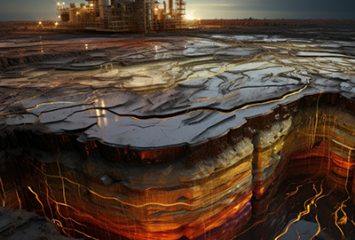

Introduction to Petroleum Geology: Learn about the basic concepts and processes that form petroleum reservoirs, including plate tectonics, geological time, and rock formation.
Petroleum System: Understand the elements and processes that comprise the petroleum system, such as source rocks, reservoir rocks, migration, and trapping mechanisms.
Reservoir Fluids: Gain knowledge about the properties and behavior of reservoir fluids, including oil, gas, and water.
Exploration and Production: Explore the phases and stages of exploration, field development, and production for both conventional and unconventional resources.
Geological Mapping: Develop skills in geological mapping, interpretation of geological data, and creating contour maps and cross-sections.
Depositional Environments: Learn about various depositional environments and the reservoirs they create, including the distribution of porosity and permeability.
Geophysical Techniques: Understand the basics of geophysical techniques used in petroleum exploration, such as seismic surveys and electric logs.
Risk Management: Identify geological risks and learn how to mitigate them in exploration and production activities.
Technological Developments: Stay updated with key technological developments in the history of the oil and gas industry and their impact on petroleum geology.
Broadening Geological Vocabulary: Enhance your understanding of geological terms and concepts relevant to the petroleum industry.
Understanding Geological Principles: Learn about fundamental geological principles and processes, such as plate tectonics, rock formation, and structural geology.
Exploring Petroleum Reservoirs: Describe how petroleum reservoirs and source rocks are formed and the processes involved in their development.
Depositional Environments: Understand various depositional environments and the types of reservoirs they create.
Porosity and Permeability: Learn about the distribution of porosity and permeability in reservoirs and how these properties affect petroleum extraction.
Geological Time and History: Gain knowledge of geological time scales and the history of Earth's geological formations.
Petroleum Origin and Migration: Understand the origin, migration, and trapping mechanisms of petroleum.
Log Correlation and Mapping: Learn how to correlate electric logs and recognize depositional environments on logs, as well as how to make contour maps and cross sections.
Geophysics and Exploration: Gain an introduction to geophysical methods used in petroleum exploration.
Application to Engineering Practices: Understand how geological knowledge is applied to engineering practices in the petroleum industry.
Introduction to Petroleum Geology
Overview of petroleum geology
The role of the petroleum geologist
Basic geological principles
Petroleum System
Elements of the petroleum system (source rock, reservoir rock, migration, trap)
Processes involved in the formation of petroleum
Reservoir Fluids
Properties of oil, gas, and water
Phase behavior of reservoir fluids
Exploration and Production
Phases of exploration
Field development and production
Exploration for conventional and unconventional resources
Geological Mapping
Techniques for geological mapping
Interpretation of geological data
Creating contour maps and cross-sections
Depositional Environments
Types of depositional environments
Distribution of porosity and permeability
Sedimentary rock types
Geophysical Techniques
Basics of seismic surveys
Electric logs and other geophysical tools
Risk Management:
Identifying geological risks
Mitigation strategies in exploration and production
Technological Developments
Key technological advancements in petroleum geology
Impact of technology on exploration and production
Practical Exercises and Case Studies
Hands-on exercises to apply theoretical knowledge
Case studies to understand real-world applications
Petroleum industry personnel in need of basic geological training, including engineering, geophysical, technical support, and administrative personnel.